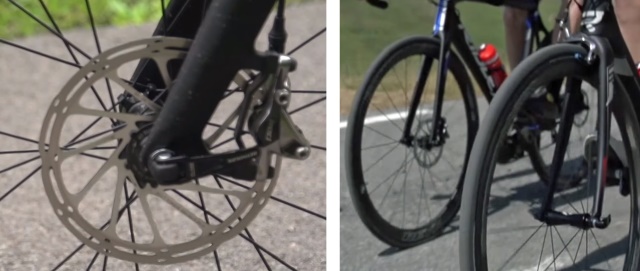Disc brakes vs Rim brakes
They've been around for a while so there is nothing really revolutionary about disc brakes. Cars abandoned rim brakes over a century ago and motorbikes? Well, they never really thought they would be any good from the start. One hundred and fifty years of the bicycle and yet the humble rim brake has held sway. The UCI (with their adherence to 'traditional' bikes) haven't helped, and the additional weight and the ability to economically manufacture all the other relevant parts (frame and fork attachments, forks able to manage hub-based brakes and levers), has hampered their widespread use. But the fact remains they are so much better for actually stopping us safely. As a purely engineering solution, they work better and, due to reduced stopping distances in the wet, are much, much safer.
Why, we should ask, are we happy to ride a seventy kilometres an hour down a fast descent with only four pieces of rubber to run against rims that heat up quickly; rims that are so perilously close to mildly compressed air in thin rubber casings. Tyres blowing out because of too much heat build-up is the least of our concerns, surely.
There is a question that is often asked about disc brakes that, perhaps, need addressing.
For the non-professional, how easy are they to set-up and maintain?
If you're going to spend more than £2,000 on your bicycle, then you shouldn't be asking this question. Would you service your BMW car from new? Besides, it's not that hard; MTB riders have been bleeding their hydraulic disc brakes for years.
Development is fast for new technology and, as uptake grows, so the costs will fall. The early mechanical disc brakes were difficult to maintain and required constant adjustment whereas the more expensive hydraulic variant are naturally self-adjusting and largely take care of themselves. They also allow one finger braking that with complete control over the power delivery - it's called modulation and will amaze cyclists when felt for the first time.
Early complaints from traditionalists who didn't like the look of the discs included the fact that pads rubbed and that under hard braking at speed, the forks would flex and steer them away from the disc. Both of these issues are now largely sorted with thru-axles of larger diameters and forks designed to counter the effects of brake steer.
Are they for everyone?
Bicycles have been designed for many different uses. Like all technology, there will be a trickle-down effect that means that some stage all bikes will be made with disc brakes. Whether this is for economic expediency or because of the realisation that they are more effective at stopping the bike, remains to be seen. But for the commuter and the sportif rider, he and she may not have the choice in future. In the same way that the professional peloton is moving to disc brakes and realising that their increased stopping power means that at some stage all teams will have to adopt them, then everyone else will have them too.
